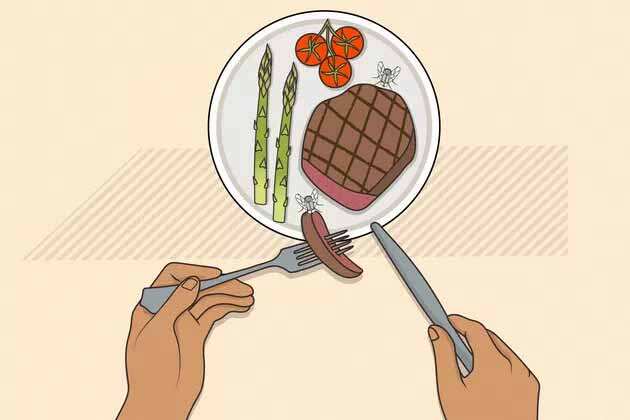
We’ve all found ourselves in this familiar situation: you’re at a barbecue, batting away bugs from your food, when you realize one has made landfall on your sandwich. While an insect buzzing around your plate can be irritating, does it actually pose any health risks?
Insects Carry a Plethora of Pathogens
“Pretty much anything you can imagine can be carried by flies and other insects,” DeVries says.
Flies — and cockroaches, too — are the two most common species that get into our food. “Both have been found to carry things like salmonella, E. coli, cholera and typhoid fever,” DeVries says.
Insects Can Transfer Pathogens to Your Food
The problem is that these pests can potentially pass on pathogens to your plate. This transfer happens through mechanical transmission, DeVries says.
Here’s what that process looks like:
- When an insect encounters a pathogen (for instance, it lands on an animal carcass or a trash bin), the germs transfer to its feet or body through touch.
- Then, the insect lands on your plate and deposits the pathogen onto your food (or a food prep surface) via bodily contact.
But it gets even grosser. Flies also spread pathogens through vomit, DeVries says. Since they don’t have teeth, they spew up spit with special enzymes that enable them to dissolve and eat food, according to the University of Sydney.
Making matters worse, flies are prone to pooping on your food too, DeVries says. And germs can be transmitted to your meal through both regurgitation and defecation.
What about if a bug lays eggs on your food? Since insects usually carry disease-causing microbes on their legs and feet (i.e., on the outside of the body) their “eggs are unlikely to carry pathogens,” Devries says. Phew.
You Can Potentially Get Sick From Eating Contaminated Food
So, now we know that bugs can transfer bacteria, viruses and parasites to your food. But what are the chances of contracting these pathogens?
“This all depends on a variety of factors,” including the following, DeVries says.
- Which types of bacteria or other possible pathogens might be in the environment (e.g., access to waste bins, sewers, etc.)
- How long the insect interacted with the pathogen sources (i.e., trash, sewage, etc.)
- How much pathogen was moved by the insect from the pathogen source to your food
- How much time the insect interacted with your food
- How long the pathogen has been “growing” on your food
- At what temperature the food was stored after pathogen exposure
Plus, certain environmental conditions can create even more opportunities for these microbes to multiply. For example, a temperature ranging between 40 and 140 degrees Fahrenheit (known as the “danger zone”) can be fertile ground for bad bacteria to flourish and cause foodborne illness, per the USDA.
And if your immune system isn’t strong, you might be more susceptible to getting sick from insect-induced food contamination. “Anyone who is immunocompromised will need to be exposed to less pathogen to develop an infection,” Devries says.
Should You Immediately Toss Food After a Bug Lands on It?
For most people, a fly’s fleeting landing on your food won’t likely lead to becoming ill.
What’s more concerning is when these critters creep about your chow for prolonged periods of time. “It probably matters how long the bug spends on your food, with longer exposure times leading to higher chances of people getting sick,” DeVries says.
“That said, I don’t know of any simple rules about when to throw out food after insect exposure,” he says.
So, what should you do if you spot a fly on your food, and you’re not sure how long it’s been loitering about? “There’s no defined ‘safe’ time, so I would advise people to go with their gut,” Devries says. Put simply: When in doubt, throw it out.
How to Keep Insects Away From Your Food
“If you limit insect contact with your food and properly store it before and after eating, the chance of major [health] problems is probably low,” DeVries says.
Here are a few tips to keep bugs at bay and far away from your fare, per the University of Sydney:
- Keep food covered while preparing, cooking and serving outdoors
- Don’t leave leftovers sitting around uncovered on the counter or outside
- If you open windows in the home, use screens to help block bugs from coming inside
- Clean trash bins regularly, discard animal waste frequently (think: pick up dog poop) and cover household garbage to detract bugs from buzzing around your home
- Use insecticidal surface sprays around trash bin areas
So, How Bad Is It to Eat Food After a Fly Landed on It?
“Long story short, bugs can certainly move lots of nasty things [to your food],” DeVries says.
Still, in most cases, a fly temporarily touching down on your dinner plate won’t make you ill if you’re in overall good health.
But it’s always best to use your judgment. When an insect lingers around your grub a little too long, there’s a greater possibility of it passing on potentially harmful pathogens. In this instance, tossing out your food may be the way to go. Better to be safe than sorry.
References:
- University of Sydney: “Should I throw away food once a fly has landed on it?”
- U.S. Department of Agriculture: “Refrigeration & Food Safety”
Important Notice: This article was also published at www.livestrong.com by Jaime Osnato where all credits are due.
Disclaimer
The watching, interacting, and participation of any kind with anything on this page does not constitute or initiate a doctor-patient relationship with Dr. Farrah™. None of the statements here have been evaluated by the Food and Drug Administration (FDA). The products of Dr. Farrah™ are not intended to diagnose, treat, cure, or prevent any disease. The information being provided should only be considered for education and entertainment purposes only. If you feel that anything you see or hear may be of value to you on this page or on any other medium of any kind associated with, showing, or quoting anything relating to Dr. Farrah™ in any way at any time, you are encouraged to and agree to consult with a licensed healthcare professional in your area to discuss it. If you feel that you’re having a healthcare emergency, seek medical attention immediately. The views expressed here are simply either the views and opinions of Dr. Farrah™ or others appearing and are protected under the first amendment.
Dr. Farrah™ is a highly experienced Licensed Medical Doctor certified in evidence-based clinical nutrition, not some enthusiast, formulator, or medium promoting the wild and unrestrained use of nutrition products for health issues without clinical experience and scientific evidence of therapeutic benefit. Dr. Farrah™ has personally and keenly studied everything she recommends, and more importantly, she’s closely observed the reactions and results in a clinical setting countless times over the course of her career involving the treatment of over 150,000 patients.
Dr. Farrah™ promotes evidence-based natural approaches to health, which means integrating her individual scientific and clinical expertise with the best available external clinical evidence from systematic research. By individual clinical expertise, I refer to the proficiency and judgment that individual clinicians acquire through clinical experience and clinical practice.
Dr. Farrah™ does not make any representation or warranties with respect to the accuracy, applicability, fitness, or completeness of any multimedia content provided. Dr. Farrah™ does not warrant the performance, effectiveness, or applicability of any sites listed, linked, or referenced to, in, or by any multimedia content.
To be clear, the multimedia content is not intended to be a substitute for professional medical advice, diagnosis, or treatment. Always seek the advice of your physician or other qualified health providers with any questions you may have regarding a medical condition. Never disregard professional medical advice or delay in seeking it because of something you have read or seen in any website, video, image, or media of any kind. Dr. Farrah™ hereby disclaims any and all liability to any party for any direct, indirect, implied, punitive, special, incidental, or other consequential damages arising directly or indirectly from any use of the content, which is provided as is, and without warranties.








